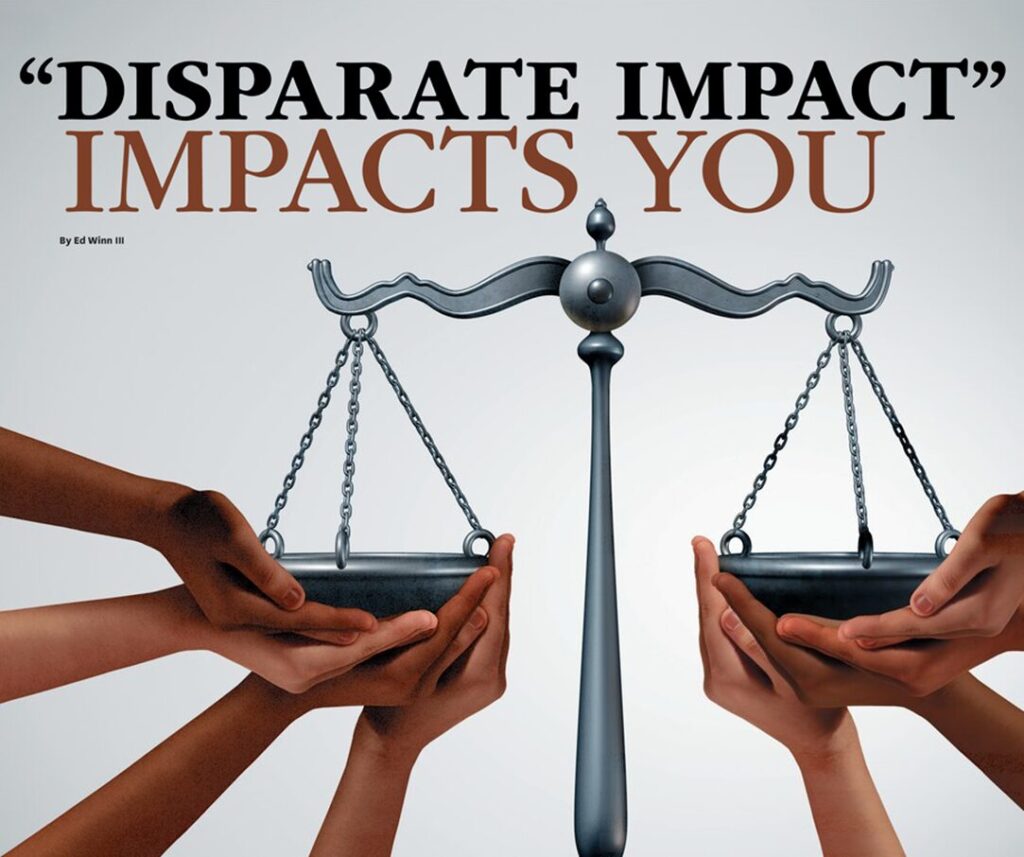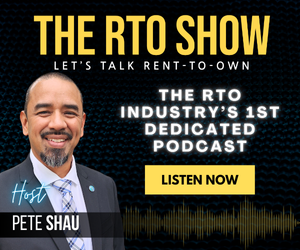There is really nothing you would rather do, day in and day out, than rent and collect. It’s in the blood. You do, at the same time, make efforts to be a good citizen, and you pay as much attention as you can to what is going on around you in the world beyond your 30-mile delivery radius. If the vitriol that permeates national politics these days distresses you, join the crowd. Everybody feels that way, no matter which side they are on.
There is, nonetheless, a national issue worth focusing on, however briefly, because it affects your life and business and it just might change in the near future. That issue is the doctrine of disparate impact.
What is Disparate Impact and Why Should You Care?
Disparate impact is the judicial doctrine that holds people and companies liable for discrimination against someone or some group in a protected class if the behavior or policy, while not intentionally discriminatory, and, in fact, is neutral on its face, has a discriminatory impact. The protected classes include race, color, religion, national origin, sex, marital status, and age. As the culture evolves, there may be more protected groups in the future. Disparate impact has mainly been applied to protect minority races and women. Most of the lawsuits have involved those two classes. However, we can anticipate disparate impact treatment of Americans with Disabilities and those with gender issues.
Application of disparate impact can affect who you hire, fire, promote and otherwise deal with as employees or potential employees, where you live, who your neighbors are, the safety of your neighborhoods, the quality of the schools where you send your kids and other aspects of your daily life.
The Griggs Case
The legal theory first arose in 1971 in a U.S. Supreme Court Case, Griggs v. Duke Power Co., 401 U.S. 424 (1971). In that case, Duke Power had two requirements for promotion to higher paying positions: a satisfactory score on an aptitude test and the possession of a high school diploma. A small class of Black employees sued alleging the company policy discriminated against them because of their race and the Court agreed. The Court held that the aptitude test and the diploma requirements were not “a reasonable measure of job performance” and that the company had a disparate impact on the employees. This was so because at the time fewer Black males had high school diplomas than White males with an estimation of 12% versus 34% in North Carolina. Also, only 6% of Black males passed the aptitude test versus a 58% pass rate for White males. The Court concluded that the company policy violated the Civil Rights Act of 1964; however, there was no evidence that the Duke policy was intended to discriminate against Blacks. Rather, the policy was doubtless created to help identify the best-qualified candidates for promotions. The Court held that Duke had the burden of proving that the requirements were reasonable measures of job performance and that Duke failed to meet that burden, since a high school diploma is a broad-based requirement and not directly related to job performance.
With the Griggs ruling in hand, the Equal Employment Opportunity Commission (EEOC) quickly developed statistical guidelines to prove disparate impact. If the protected class, mainly women and racial minorities, did not have a selection rate of at least 80% of the selection rate for the most successful group, viz. White males, that statistic alone created an inference of discrimination because of the disparate impact of the policy under consideration, whatever it might be—pencil and paper test, lifting requirements, and the like. Once the statistic has been shown, the burden then shifts to the employer to show a legitimate business justification for the policy. If the employer can make such a showing and courts have been reluctant to accept employer arguments, the aggrieved plaintiff can still prevail by showing a policy that would work in the business and would have less of an impact on the protected group.
Years ago, the RTO industry had to defend at least two class action lawsuits alleging sex discrimination—the disparate treatment of women in the RTO workplace. Those cases both resulted in multi-million dollar settlements and since then the industry has seen many more women hired and overall, the industry is much less sexist than it once might have been.
The Disparate Impact of Criminal Background Checks
Since the Griggs ruling, the government has used disparate impact in an ever-widening circle of circumstances, primarily in the employment arena but the concept has been extended far beyond employment. As an example of the expansion of the notion in 2012, the EEOC issued an Enforcement Guidance encouraging employers not to look into the criminal records of job applicants because of the disparate impact on Blacks and Hispanics from such inquiries. The incarceration rates for Blacks is roughly seven times greater than for Whites in the country; for Hispanics, the rate is three times higher than for Whites. The problem with this policy, of course, is that companies would then be hiring a higher percentage of ex-cons, exposing the companies to internal theft, fraud, workplace violence, and other crimes. The workplace could potentially become less safe. RTO dealers were cautioned about following the EEOC’s Guidance shortly after it was issued. See “Is There an Ex-Con in Your Future?” RTOHQ: The Magazine, March-April 2013, page 40.
In a case against The Freeman Companies, a federal district court judge ruled against the EEOC’s guidance and awarded the company some $1 million in attorneys’ fees and noted acerbically the hypocrisy of the EEOC as that agency conducts criminal background checks on 90% of its own employees. The Guidance suggested that if companies do run criminal background checks, it should delve deeper into the applicant’s background before making a decision. Any number of companies are complying with the Guidance today, recognizing the risks and costs of an EEOC investigation into their hiring practices. It is a fact of political life for employers that they face a Hobson’s choice these days. Run criminal background checks on potential hires and risk the ire of the EEOC or don’t run the checks and risk mayhem in the workplace.
It’s Not Just in the Workplace
The EEOC has sued hundreds of school districts because statistics show that Black students were being disciplined at higher rates than White students, a disparate impact that proved minority students were being discriminated against by teachers and administrators. The result of the suits has been a relaxation of discipline enforcement overall in schools with noticeable increases in violence against students and teachers as well. One reads daily of the decline of performance and test scores in public schools, not to mention teacher strikes and overall teacher disenchantment with the profession. Disparate impact rulings are one of the reasons for the decline in public school systems, albeit not the only one. The government issued disparate impact mandates in 2014 aimed at the statistics of suspensions and school-related arrests. The current administration recently rescinded that rule, but there was no mention of the disparate impact doctrine, which is presumably still intact. Thus, school systems are still nervous about what rules apply, and if your children are students in large inner-city schools, they are at higher risk of physical violence because of disparate impact.
The statistics upon which the government relied for the guidance showed that Black students were disciplined three times more often than White students. When those statistics were probed, however, the racial gap was found not to have been caused by biased school administrators, but rather by the histories of bad behavior, both in and out of school, of minority students. In 2017, a study by the Centers for Disease Control concluded that minority students’ misbehavior in school could be attributed primarily to single-parent families, domestic abuse, and poverty—not discrimination.
Community Safety and Disparate Impact
The government has sued city and local governments and police and fire departments, using disparate impact statistics to demonstrate bias in hiring and promoting fire and safety personnel, criminal court fines, traffic stops and arrests, and other aspects of local criminal justice systems. The result has been an overall decrease in stops and arrests and an increase in crime. Landlords have likewise been discouraged and threatened from using criminal background checks on prospective tenants because the result might have a disparate impact on minorities. That means you may not only have ex-con employees, but you may also have one living next door.
Disparate Impact and Credit
No sooner did the Consumer Financial Protection Bureau (CFPB) come into existence in 2010 than it began to adopt disparate impact applications to the credit world. To be sure, RTO is not strictly speaking, in the credit world, and the CFPB has no jurisdiction over the transaction, but RTO is never very far away from credit. The CFPB and before it, the EEOC, have challenged banks and other lenders over their home loan policies and the impact of those policies on minority borrowers. There are some who argue that the 2007-2008 financial meltdown can be directly attributed to subprime mortgage loans to minorities that were unsoundly made to the tune of billions of dollars and made primarily to avoid discrimination lawsuits based on the disparate impact of the lending policies of the banks.
In 2013, the CFPB cautioned third-party vehicle lenders that they might be investigated for discriminating against women and minorities because of the disparate impact analyses of interest rates and other terms in loans to those protected classes of people. Under Cordray’s leadership, the CFPB exacted a $98 million fine from Ally Financial, the country’s largest third-party auto lender, over charges that the company’s loan approval rates and finance charges resulted in racial discrimination against minorities, using a disparate impact analysis. The bank argued that the difference in rates was due to differences in credit scores. The CFPB ignored credit scores completely in its analysis, relying exclusively on the race of the borrowers.
When the former CFPB head, Mr. Cordray stepped down, and Mr. Mulvaney stepped in on an interim basis, the Bureau rescinded the guidance, using the Congressional Review Act, a first in the history of the Bureau.
Critics of disparate impact predict that the next line of attack will be at credit scores, themselves. The Federal Reserve Board has found that “the differences in credit scores among racial or ethnic groups are large, with 53% of Blacks scoring in the bottom quintile of creditworthiness versus 16% of Whites in that category.” Those critics predict that the credit reporting agencies who merely collect information from the marketplace and disseminate it are in the sights of several government agencies. Representative Sheila Jackson Lee (D-Texas, District 18) has announced her intention to form a new group in the House Judiciary Committee and to use disparate impact to help compensate Blacks for slavery: The Commission to Consider Reparation Proposals for African Americans.
Conclusion
The current administration is reviewing a proposed executive order that would prohibit the use of “the disparate-impact approach in the enforcement or application of any civil-rights law.” Such an order would be one of the most significant decisions coming out of D.C. in decades. Whether it will get the President’s signature remains to be seen and if it does, it is likely that Congress and the courts will fight back. The future of disparate impact, as is the case with many political issues these days, is very much up in the air. Is it still a viable and important doctrine to be used to ferret out instances of hard-wired discrimination that pervades American life or is it a doctrine that has run its course and should be abandoned? Dealers need to be aware of disparate impact and how it affects their lives. Now they are.
Application of disparate impact can affect who you hire, fire, promote and otherwise deal with as employees or potential employees, where you live, who your neighbors are, the safety of your neighborhoods, the quality of the schools where you send your kids and other aspects of your daily life.
Ed Winn III serves as APRO General Counsel. For legal advice, members in good standing can email legal@rtohq.org.











